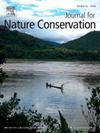海洋岛屿特有微型蝙蝠的洞穴栖息特化提高了洞穴面临多重威胁时的灭绝风险
IF 2.2
3区 环境科学与生态学
Q2 BIODIVERSITY CONSERVATION
引用次数: 0
摘要
蝙蝠(Chiroptera)占全球哺乳动物多样性的五分之一,有 1450 多个物种。然而,16.5%的蝙蝠濒临灭绝,这种情况在岛屿上更加严重,突出表明迫切需要在那里开展保护工作。然而,只有了解这些岛屿物种的基本生态,才能采取有效的保护行动。毛里求斯有一种特有的濒危洞栖食虫蝙蝠,近年来数量不断减少,但对其生态学却知之甚少,这阻碍了对其的保护。我们将醋栗蝠(Mormopterus acetabulosus)作为样板物种,为在高度变化的栖息地中保护食虫岛屿蝙蝠提供信息。我们比较了该物种历史上和目前已知的栖息地分布和规模,并使用 GeoCAT 估算了其栖息地面积(AOO)和出现范围(EOO)的变化。我们还汇编了蝙蝠栖息和未栖息洞穴的物理特征、环境和人为变量,以确定影响蝙蝠栖息的潜在因素。我们在记录的 130 个熔岩洞穴隧道中的 17 个发现了蝙蝠栖息地,比之前记录的 9 个有所增加,其中包括 11 个永久性栖息地和 6 个季节性栖息地,大部分(∼71 %)位于私有土地上。与2017年的上次调查相比,EOO稳定在818.9平方公里,而AOO增加了33.3%。这种扩大可能反映了以前未被发现的栖息地或最近的殖民事件,或两者兼而有之。洞穴尺寸(入口大小和高度)、洞穴数量、相对湿度和与水的距离最能解释醋栗蝠的栖息地占用情况。入口较大的洞穴可能更适于栖息,因为这一特点便于移动和躲避捕食者,而较大的洞穴可能更适于提高微气候的稳定性。尽管洞穴的微气候没有明显的差异,但发现有人居住的洞穴和无人居住的洞穴在物理特征方面存在差异。根据这些洞穴的特征及其对增加该物种的EOO和AOO的潜在贡献,目前无人居住的六个洞穴被确定为未来保护工作的优先地点。为了降低濒临灭绝的风险并保护其相关的生态功能,有必要对所有洞穴进行法律保护,无论这些洞穴目前是否有蝙蝠栖息。本文章由计算机程序翻译,如有差异,请以英文原文为准。
Cave-roosting specialisation of an oceanic island endemic microbat elevates extinction risks as caves face multiple threats
Bats (Chiroptera) constitute one-fifth of the global mammalian diversity, with over 1,450 species. Yet, 16.5 % of them are threatened with extinction, a situation exacerbated on islands, underscoring an urgent need for conservation efforts there. However, effective conservation action can only be as sound as the understanding of the basic ecology of such insular species. Mauritius harbours one endemic Endangered cave-roosting insectivorous bat, in recent decline, whose ecology is poorly known, hampering its conservation. We used Mormopterus acetabulosus as a model species to inform insectivorous island bat conservation in highly transformed habitats. We compared the species’ historical and current known roost distribution and sizes and estimated any change in its Area of Occupancy (AOO) and Extent of Occurrence (EOO) using GeoCAT. We also compiled the physical characteristics, environmental and anthropogenic variables of caves that are occupied and unoccupied by the bats to identify potential factors influencing roost occupancy. We found roosts in 17 of the recorded 130 lava cave tunnels, up from the nine previously recorded, including 11 permanent and six seasonal roosts, mostly (∼71 %) on privately owned land. Compared to the last surveys in 2017, the EOO remained stable at 818.9 km2, while the AOO increased by 33.3 %. This expansion may reflect previously undetected roosts or recent colonisation events or both. Cave dimensions in terms of entrance size and height as well as the number of chambers, relative humidity and distance to water best explained roost occupancy by M. acetabulosus. Caves with larger entrances may be preferred for roosting as this characteristic eases manoeuvrability and predator avoidance, and larger caves may be preferred for enhanced microclimatic stability. Occupied and unoccupied caves were found to differ in terms of physical characteristics, although cave microclimate did not vary notably. Based on their characteristics and their potential contributions to increasing the species’ EOO and AOO, six currently unoccupied caves were identified as priority sites for future conservation efforts. Legal protection of all caves, regardless of current bat occupancy is necessary to mitigate extinction risks and preserve their associated ecological functions.
求助全文
通过发布文献求助,成功后即可免费获取论文全文。
去求助
来源期刊

Journal for Nature Conservation
环境科学-生态学
CiteScore
3.70
自引率
5.00%
发文量
151
审稿时长
7.9 weeks
期刊介绍:
The Journal for Nature Conservation addresses concepts, methods and techniques for nature conservation. This international and interdisciplinary journal encourages collaboration between scientists and practitioners, including the integration of biodiversity issues with social and economic concepts. Therefore, conceptual, technical and methodological papers, as well as reviews, research papers, and short communications are welcomed from a wide range of disciplines, including theoretical ecology, landscape ecology, restoration ecology, ecological modelling, and others, provided that there is a clear connection and immediate relevance to nature conservation.
Manuscripts without any immediate conservation context, such as inventories, distribution modelling, genetic studies, animal behaviour, plant physiology, will not be considered for this journal; though such data may be useful for conservationists and managers in the future, this is outside of the current scope of the journal.
 求助内容:
求助内容: 应助结果提醒方式:
应助结果提醒方式:


